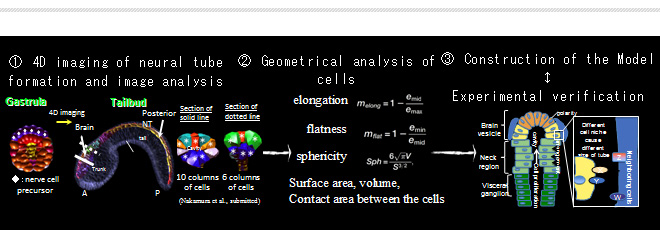|
HOME > Proposed research projects > 2012-2013: Proposed research projects 10
 2012-2013: Proposed research project 10Quantitative Analysis of Brain Vesicle Formation by 4D imaging
Purpose of the Research ProjectDifferent region of central nervous system, fore brain, mid brain, hind brain and spinal cord originates from one neural tube at organogenesis period. Defects of neural tube formation cause severe diseases, including anencephaly and spina bifida. While understanding of differentiation at the molecular level has been deepened, the molecular mechanism of the morphogenesis of neural tubes at different regions remains to be clarified. One of chordate, ascidian also have a vertebrate-like neural tube during larval period and transcription factors related to differentiation also conserved. Ascidian develop mosaic and cell lineages are well know until tailbud stage. Neural tube at tailbud stage consists of only ~300 cells (Nakamura et al., submitted). In this study, we challenge to clarify mechanisms of neural tube formation at single cell levels: how direction neural tube precursor cell divide, how polarized to form tubular structures; how disruption of neural tube structures results in defects of neural tube closure. Content of the Research ProjectTo understand the mechanism of producing different morphological features in different region of central nervous system, simultaneous analysis at both cell-level and tissue-level are required. However vertebrate neural tube consists of huge number of cells and both analysis have been separately studied. On the other hand, ascidian, small and simple chordate animal, can be observed all of cell arrangement, cell division, cell proliferations and cell polarity in one microscope field of view. In addition, limited number of cells enable us to analyze quantitative and geometrical approach for each cell. Expected Research Achievements and Scientific SignificanceProgress of the mechanism of producing different morphological features in different region of central nervous system would lead to the elucidation of the cause of disease related neural tube closure. Human brain is evolved by enlargement of the forebrain. If our research progress advanced, the mechanism of the size regulation in different brain region would be clarified. It is also expected to contribute to understanding of the evolution of central nervous systems in vertebrates.
|








